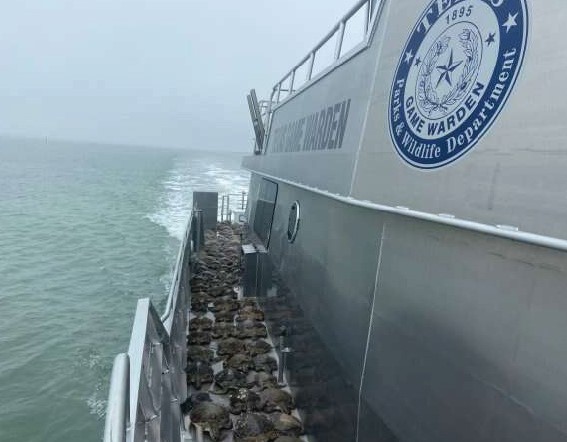- La Feria Community Holds Succesful Business Mixer Event
- Little Nashville to Take Place in Downtown Mercedes
- Lions Basketball Captures District Gold
- La Feria ISD Students Compete in Regional Chess Tournament
- Lions End First Half of 32-4A on a High Note
- La Feria ISD Held Another Successful Parent Conference
- Strong Appearance for Lions at Hidalgo Power Meet
- LFECHS Students Get to Meet Local Actress
- Students Participate in Marine Biology Camp
- Two LFECHS Students Qualify for All-State Band
Cold-stunned sea turtles, frozen alligators fight for their lives after unprecedented cold snap
- Updated: March 5, 2021

Residents of Texas are still feeling the effects of an intense winter storm that moved through the United States last week, which, The Associated Press reported, was responsible for at least 69 fatalities across the country — and wildlife is suffering from the extreme cold as well, causing a turtle rescue to get underway in the state.
A massive sea turtle rescue was underway in Texas after extreme weather in the state has led the sea creatures to become stunned by the cold.
Sea turtles are ectothermic, or cold-blooded creatures, meaning they cannot regulate their own body heat. If the water they inhabit drops below 50 degrees Fahrenheit like it did during the extreme cold in Texas this week, the turtles develop hypothermia and become lethargic and unable to swim, according to the U.S. National Park Service.
When the turtles enter the cold-stunned state, they float to the top of the water, which puts them in jeopardy of being struck by boats or the potential of washing ashore and becoming stranded on land. It also puts them at heightened risk for being preyed upon by natural predators.
Texas Game Wardens in Cameron County rescued 141 sea turtles that fell victim to the cold weather in the Brownsville Ship Channel and surrounding bays.
Wendy Knight, the executive director of Sea Turtle, Inc. in South Padre Island, Texas, posted a video on Facebook on Monday calling attention to the struggles the organization faced amid the winter storm.
“We are undergoing one of the largest cold-stun events the island has seen in more than a decade,” Knight said. “Between yesterday and today, we’ve taken well over 500 cold-stunned turtles.”
At 2 p.m. on Monday, the organization lost power, which has left their five, 25-55,000 gallon tanks holding the stunned turtles without heat — putting the lives of the turtles at risk.
“All of these efforts will be in vain if we do not soon get power restored to our facility,” Knight said.
On Wednesday, SpaceX arrived at the facility with giant generators that were strong enough to support the organization’s electrical needs that allowed the turtles in Sea Turtle, Inc’s care to warm back up. The following day, Knight posted another update and called the event “the largest cold-stun event in recorded history.”
On Friday, the organization tweeted that the organization rescued over 4,900 turtles.
Gulf World Marine Institute in Panama City, Florida, regularly performs sea turtle rescues when the local turtles become cold-stunned. The staff at the institute told AccuWeather earlier this winter that they focus on getting the turtles to eat and swim again so they can be released back into the wild. Recovery for the turtles can take weeks if the turtle recovers quickly, but for others, it can take upwards of a year.
“[We have] critically cold-stunned turtles,” the institute’s stranding coordinator, Lauren Albrittan told AccuWeather’s National Reporter Kim Leoffler last month. “What that means is most likely they have secondary infections or injuries or other illnesses other than just being too cold.”
Between December 2017 and January 2018, the Texas coast had its largest amount of cold-stunned sea turtles to date with over 3,500 turtles.
Sea turtles were not the only wildlife to be impacted by the extreme and unusual cold. David Arbour, an employee for the Oklahoma Department of Wildlife Conservation, posted photos to his Facebook account on Wednesday of a shocking sight — alligators frozen in ice with just their snouts sticking out of the frozen bodies of water.
The photos capture a natural phenomenon called “icing” and it is how the alligators keep themselves alive in the extreme weather, CNN reported. Icing is the reptiles version of hibernation in which they lower their metabolic rates, become lethargic and keep their snouts above the frozen water and allow the ice to freeze around their snouts.
“The gators won’t freeze if the water stays liquid,” Arbour said in a comment on his post. “Their snouts are just cartilage so freezing doesn’t hurt their snouts. They can still move and are aware of things.”
Unlike the cold-stunned turtles, the alligators will survive without intervention from rescue organizations. Arbour explained in the comments that the alligators keep their snouts above the ice to breathe, and they will be able to survive the cold conditions.





